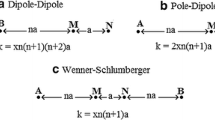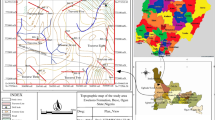Abstract
Measurements of electrical resistivity anomalies using a Wenner electrode array in a profiling mode were conducted over a 105-acre area near Crystal River, Florida Analyzed results of collected data were used to determine the likelihood of subsurface solution cavities beneath a proposed ash disposal area “Sounding” measurements with electrode spacing values extending up to 100 feet and Lee electrode measurements were used to identify and locate specific anomaly maxima identified anomalies on the order of 200 chms-feet contrasted with expected values of 300 to 400 ohms-feet and were attributed to lower resistivities inherent in water-filled solution cavities below a shallow water table Prominent cavity complexes at 5 to 15 feet depth were predicted in areas of low resistivity anomalies in the otherwise geoelectrically uniform, Eocene Ocala limestone Shallow test borings confirmed the presence of a significant concentration of shallow cavities in the predicted areas This study demonstrated the feasibility of electrical resistivity measurements as a reconnaissance tool to economically determine subsurface cavities and to aid in developmental and environmental planning
Similar content being viewed by others
References Cited
Bates, E. R., 1973, Detection of subsurface cavities: ULSL Army Engineer Water Experiment Station Misc. Paper S-73-40, 63 p.
Fountain, L. S., F. X. Herzig, and T. E. Owen, 1975, Detection of subsurface cavities by surface remote sensing techniques: Southwest Research Institute Report No. FHWA-RD-75-80, 126 p.
Puri, H. S., and R. O. Vernon, 1964, Summary of the geology of Florida and a guidebook to the classic exposures: Fla. Geol. Survey Special Publ. No. 5, 312 p.
Randazzo, A. F., and H. C. Sarpoo, 1976, Sedimentology and paleoecology of Middle and Upper Eocene carbonate shoreline sequences, Crystal River, Florida, U.S.A.: Sedimentary Geol., v. 15, p. 259–291.
Smith, D. L., and A. F. Randazzo, 1975, Detection of subsurface solution cavities in Florida using electrical resistivity measurements:Southeastern Geol., v. 16, p. 227–240.
Smith, D. L., and D. G. Short, 1982, Detection of subsurface solution cavities with pole-dipole electrical resistivity measurements: Geol. Soc. Amer. Abst. with Prog., v. 14, p. 83.
Vernon, R. O., 1951, Geology of Citrus and Levy Counties, Florida:Fla. Geol. Surv. Bull, v. 33, 256 p.
Van Nostrand, R. G., and K. L. Cook, 1966, Interpretation of resistivity data: U.S. Geol. Surv. Prof. Paper No. 499, 310 p.
Winston, G. O., 1976, Florida's Ocala uplift is not an uplift. Amer. Assoc. Petrol. Geol. Bull., v 60, p. 992–994.
Author information
Authors and Affiliations
Rights and permissions
About this article
Cite this article
Denahan, B.J., Smith, D.L. Electrical resistivity investigation of potential cavities underlying a proposed ash disposal area. Environ. Geol. Water Sci 6, 45–49 (1984). https://doi.org/10.1007/BF02525569
Issue Date:
DOI: https://doi.org/10.1007/BF02525569




